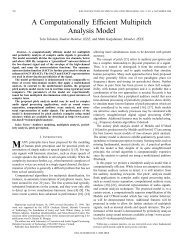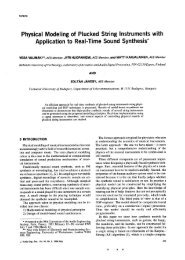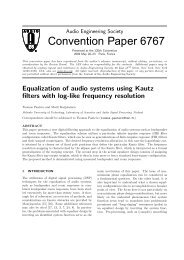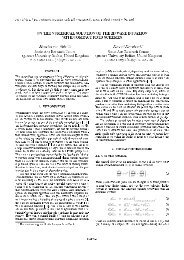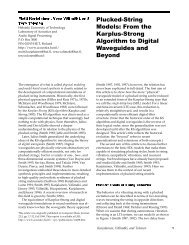Evaluation of learning in computer based education using log ...
Evaluation of learning in computer based education using log ...
Evaluation of learning in computer based education using log ...
- No tags were found...
Create successful ePaper yourself
Turn your PDF publications into a flip-book with our unique Google optimized e-Paper software.
Session 12a3tomatically generated rcport <strong>in</strong> this case was student's ownfrequency mask<strong>in</strong>g curve, which helshe could easily comparewith theoretical results.The automatic report generat<strong>in</strong>g is a useful concept <strong>in</strong>every CBE application that <strong>in</strong>volves measurements (real orsimulated) or testlqucstion-like <strong>in</strong>teractivity.The studcnts can also be given access to their own <strong>log</strong>files afterwards. Analyz<strong>in</strong>g the <strong>log</strong>s by themselves wouldeasily po<strong>in</strong>t out issues and topics thnt were not thoroughlyexam<strong>in</strong>ed and cstimate what topics should bc given furthernotice. Basically, the analysis could be similar to the oneteachers pcrfnrrn, but <strong>in</strong> this case, it would only evaluate the<strong>learn<strong>in</strong>g</strong> process <strong>of</strong> an <strong>in</strong>dividual student.7. WWW LOG SYSTEMIn the last few years, the WWW (World Wide Web) has becomeperhaps the most important tool for CBE. From thevery beg<strong>in</strong>n<strong>in</strong>g, WWW scrvcrs (httpd) havc <strong>in</strong>cluded a <strong>log</strong>g<strong>in</strong>gmcchanism as well. Like many other Internet services,the httpd <strong>log</strong> system has been designed ma<strong>in</strong>ly for "hit-rate"type statistical analysis or debugg<strong>in</strong>g purposes, but <strong>in</strong> hctit is one <strong>of</strong> the most flexible and well-designed <strong>log</strong> systemsaround.To be precise, the WWW <strong>log</strong> systcm is a sum <strong>of</strong> threecomponents: 1) the server s<strong>of</strong>tware, 2) the client s<strong>of</strong>twareand 3) the HI'l'P protocol. The <strong>in</strong>formation that is written tothc <strong>log</strong> depends on thc server s<strong>of</strong>twarc and also the paramctersthnt are sent by the browser. 'I'he <strong>in</strong>formation exchangeis done withiti thc c~pabilities <strong>of</strong> the HTTP protocol [4].A typical httpd <strong>log</strong> cunta<strong>in</strong>s (example takcn from thedocumentation <strong>of</strong> one <strong>of</strong> thc most popular WWW-servers.apache (http://ww. apache. orq/)):host ident authuscr date request stntns byteswhcrc the tokens archost The fully~qiialifiecl doma<strong>in</strong> name <strong>of</strong> the client, orits IP number if the name is not avoilnble.idcnt IT IdentityCheck is enabled and the client mach<strong>in</strong>eruns itlentcl; then this is the identity <strong>in</strong>formationrcported by the client.authiiser If the rcqucst was for n password protectedducumcnt, then this is thc userid used <strong>in</strong> thc request.date The date and time <strong>of</strong> the request, <strong>in</strong> fonnntdaylmonthlyemhour: m<strong>in</strong>ute:second zonerequest The request l<strong>in</strong>e (url) from the client, enclosed<strong>in</strong> double quotes (").status The thrcc digit status codc rcturnerl to the clicnt.bytes The number <strong>of</strong> bytcs <strong>in</strong> the object returned to theclient, not <strong>in</strong>clud<strong>in</strong>g any hcaders.1fa token docs not have a value then it is represented by ilhyphen (-1.The above is called Common Log Format (CLF) and the<strong>in</strong>Formation is written to so called TransferLog. Apacheserver also has a possibility to use customized <strong>log</strong> formatswith a number <strong>of</strong> additional keywords. Howcvcr, the CLF assuch is adequate for most purposes except for two particulartokens, Refercr and User-Agent. The Refercr is the url tuthe page from where the user came from (via HTML-l<strong>in</strong>k)and User-Agent, an id-str<strong>in</strong>g <strong>of</strong> the browscr s<strong>of</strong>tware send<strong>in</strong>gthe request. Apache server can bo configured to storethese directly to TransferLog with custom <strong>log</strong> commands"W{Refcrcr}i" and "%{User-Agent}i". Errors are usuallywritten to a separate ErrorLog with similar <strong>in</strong>formntion tpossibly scime deiails <strong>of</strong> the error itself.The <strong>log</strong> systems <strong>in</strong> other WWW-servers vary both <strong>in</strong>format and <strong>in</strong> customisability but thc differences are quitesmall.On a busy server the <strong>log</strong> files easily become very big andthus difficult to handle. Hence there is a number <strong>of</strong> specializcdWWW <strong>log</strong> analysis tools available, for <strong>in</strong>stance nndog(http://www.statslab.cam.ac.uk/"sretl/ana<strong>log</strong>/)or WUmp (http://www.boutell .com/wusage/). Themost advanced ones are very fast and customiznble <strong>in</strong> terms<strong>of</strong> analysis paramctcrs and <strong>in</strong>put or output format, butusually they provide only basic statistical measiires such ashit rates etc.8. LEARNING EVALUATION WITH WWW LOGSYSTEMFrom the po<strong>in</strong>t <strong>of</strong> view <strong>of</strong> <strong>learn<strong>in</strong>g</strong> evaluation, it is importantto notice that the basic <strong>log</strong>g<strong>in</strong>gmakes it somewhat irnpossibleto tracc back <strong>in</strong>dividual users' requcsts. A standardsolution is to use authentication to restrict access tothe contents. Most WWW servers and brnwsers supportauthentication and <strong>in</strong> its simplest form, uscr ;iuthenticationis easy to implcmcnt. Usually nuthenticat<strong>in</strong>n <strong>in</strong>volves alsoaccount management, preferably as automatic as possible,which is not simple to implement (not be<strong>in</strong>g very difficultcither, though). A gouood management system would allowstudents (or anyone) to register on-l<strong>in</strong>e and create the necessaryaccount immediately as well as methods for tak<strong>in</strong>g care<strong>of</strong> chang<strong>in</strong>g password or remov<strong>in</strong>g account. If user authenticationis used, it is possiblc to do <strong>of</strong>f-l<strong>in</strong>e evniuation andannlysis similar io one presented <strong>in</strong> section 4.Another disadvantage <strong>of</strong> the basic WWW <strong>log</strong> systcrn isthat the <strong>in</strong>formation is writtcn only on B request basis. loput it <strong>in</strong> other words: it doesn't remember anyth<strong>in</strong>g. In orderto use <strong>log</strong>g<strong>in</strong>g for purposes such as <strong>in</strong>teractive guidanceor on-l<strong>in</strong>e evnluation, morc advanced techniques arc needed.Two basic solutions are available: 1) produc<strong>in</strong>g thc contentNovember 10 I 13,1999 San Juan, Puerto Rico29th ASEWIEEE Fronticrs <strong>in</strong> Education Confcrciice12a3-19






